Introduction: Harvest time in north Missouri is a season of long days and heavy labor. For many farmers, it’s also back pain season – but it doesn’t have to be. Research shows farmers experience more back pain than the general population due to the physical demands of the job[1]. In fact, a recent Midwest survey found 40% of farmers had lower back trouble in the past year, and 68% of those said it actually kept them from doing their work[2]. Yet as one agricultural health expert put it, “Back pain doesn’t have to be an unavoidable part of farming”[3]. In other words, with the right strategies, you can bring in your harvest without breaking your back.
In this guide, we’ll explain why farm work can wreak havoc on your spine and share five back-saving tips to help Missouri farmers stay pain-free through harvest. We’ve helped many local farmers around Chillicothe get through harvest time pain-free, and we want the same for you. Let’s cultivate a healthier back this season!
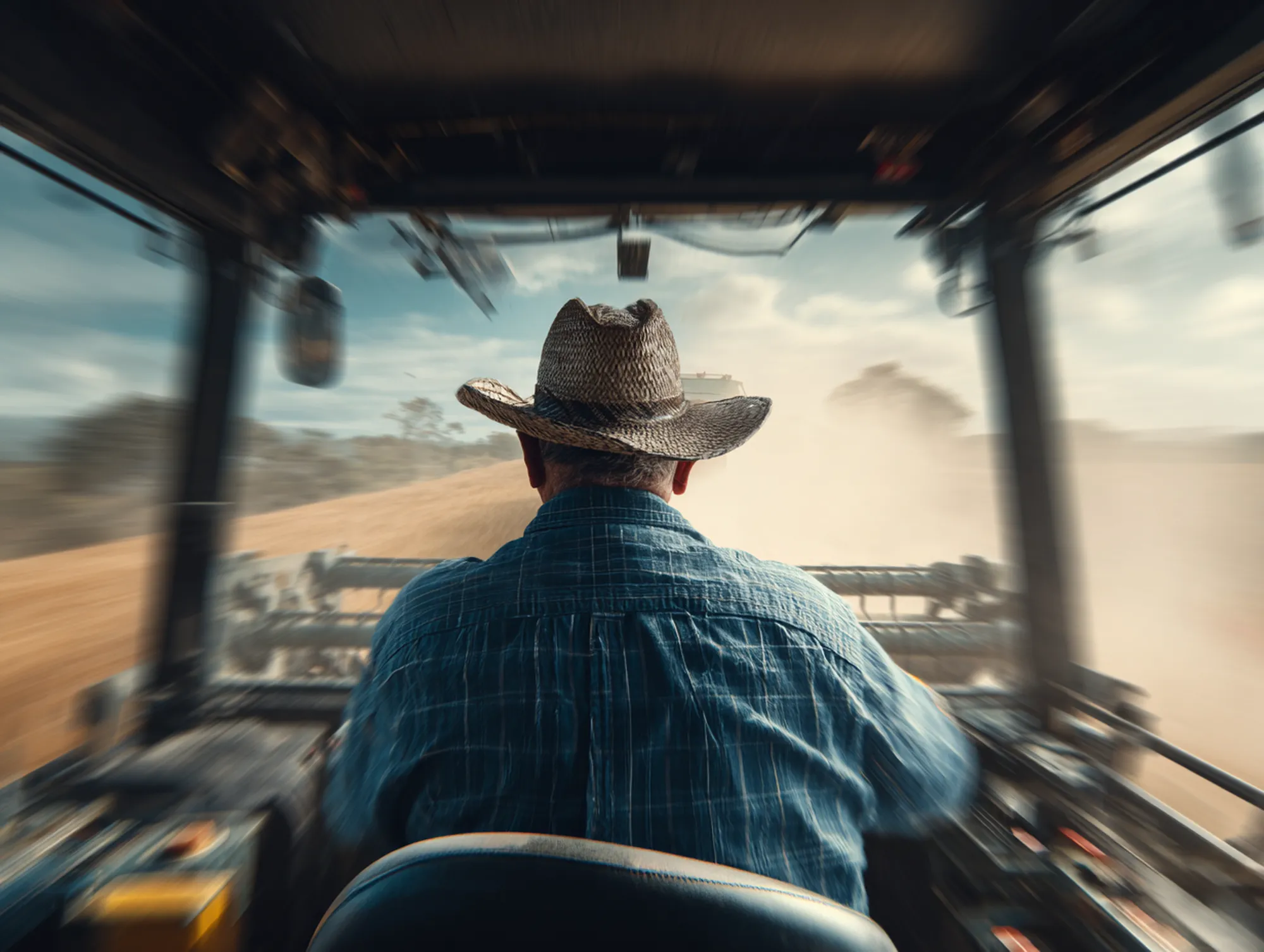
Why Harvest Season Strains Your Back
Every job has its aches and pains, but farming hits the back especially hard. Here are a few reasons harvest work can take a toll on your spine[4][5]:
- Heavy lifting: Hauling large hay bales, seed sacks, or feed bags can overload your spine – especially if you lift with poor form. Lifting and carrying heavy loads repeatedly throughout the day puts tremendous strain on back muscles and discs.
- Machine vibration: Hours spent riding tractors or combines shakes your whole body. That constant vibration (think of the engine rumbling through the seat) increases the risk of low back pain[6]. Studies from the University of Iowa found that the whole-body vibration of farm machinery is linked to back problems in farmers[7].
- Repetitive motions & awkward postures: Farm tasks often involve twisting, bending, and reaching in less-than-ideal positions. Whether you’re hooking up implements, tending animals, or picking crops, working bent over or twisted to the side can strain your back muscles over time.
- Long hours sitting: Harvest means long days in the driver’s seat. Prolonged sitting on the tractor (especially without good lumbar support) can stiffen your spine. You might not feel it while you’re focused on the field, but after hours of being jolted around in a seat, your lower back can be screaming.
A Missouri farmer hefts a heavy hay bale during harvest. Lifting and carrying bulky loads all day can stress the spine if done incorrectly[8]. Using proper form and assistive equipment can help prevent these injuries.
Bottom line: Farming is tough on the back. But with a few smart habits and adjustments, you can reduce these risks. As we often remind our patients, your body is your most important piece of farm equipment – take care of it, and it will take care of you.
5 Tips to Prevent Back Pain on the Farm
Harvest time doesn’t have to equal back pain time. By working a little smarter, you can safeguard your spine and keep yourself in the field all season. Here are five chiropractor-approved tips for farmers:
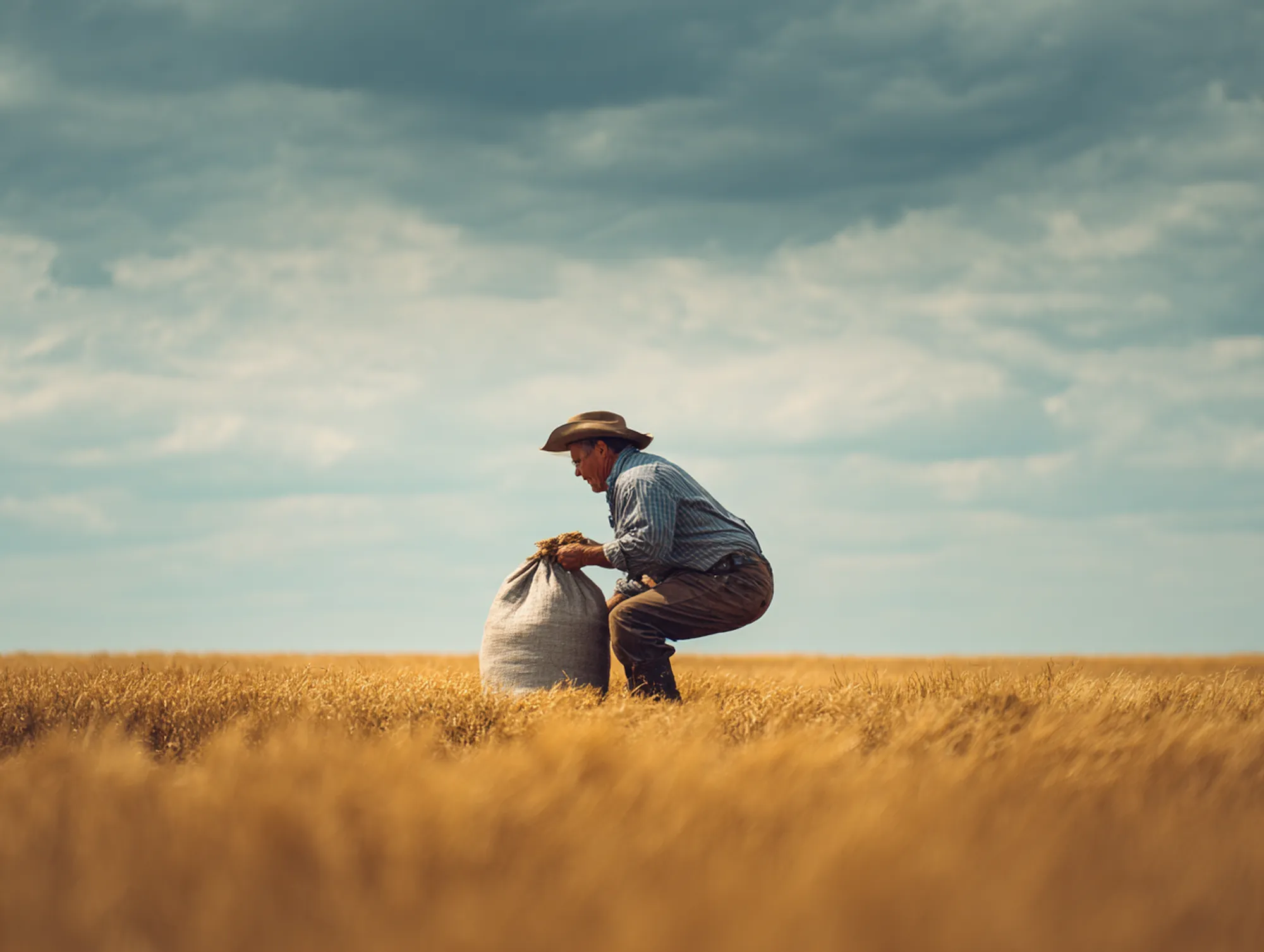
Tip 1: Lift Smarter, Not Harder
When it comes to heavy lifting, technique is everything. Rather than straining your back trying to be a hero, use your legs and leverage to do the work. For example, when lifting seed bags or buckets:
- Bend at your knees, not at your waist. Squat down, keep your back straight (no hunching), and lift by pushing through your legs[9]. Your leg muscles are far stronger than your back muscles – let them carry the load.
- Hold items close to your body. Keeping the weight close to your center of gravity reduces stress on your spine[10]. Hug that feed sack to your torso instead of carrying it at arm’s length.
- Don’t twist while lifting. If you need to turn with a heavy load, pivot your feet instead of twisting your back. Repetitive twisting under load can easily tweak a disk.
- Lighten the load and get help. Break down heavy loads into smaller ones when possible (e.g. half-fill the feed buckets). Better yet, use tools or an extra set of hands: two people lifting a hay bale (or using a skid loader/forklift) is a lot safer than one person doing it alone. There’s no shame in asking a farmhand or family member to assist – it beats being laid up with an injury.
Investing in simple equipment can make lifting safer too. Handcarts, dollies, hay bale spears, hydraulic lifts – these tools exist to spare your back. As one extension specialist advises, use assistive technologies or labor-saving devices for tasks that exceed your physical limits[11][12]. Work smarter by letting machines carry some of that weight.
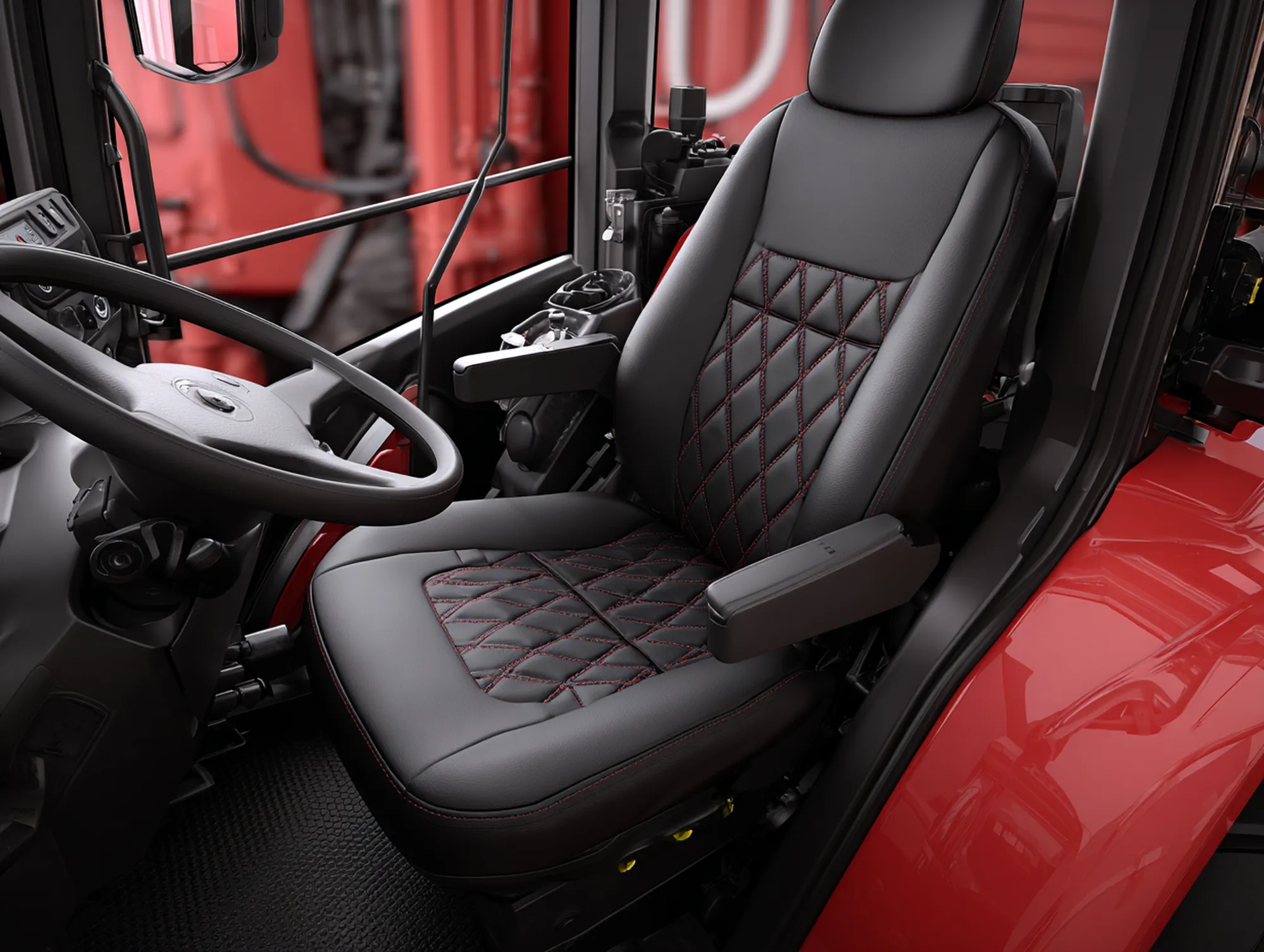
Tip 2: Use Farm-Friendly Ergonomics
“Ergonomics” isn’t just an office word – it matters on the farm, too. Setting up your environment and using supportive gear can greatly reduce strain on your body:
- Optimize your tractor seat and cab: Adjust your tractor or combine seat for good posture. Your thighs should be parallel to the floor and your back should be supported. If your tractor has an old seat with worn-out padding, consider upgrading to a suspension seat or adding a cushion with lumbar support[13][14]. This can absorb a lot of the bumps and jolts before they hit your spine. Also, use your mirrors or even install a backup camera, so you avoid constant twisting to look behind[15][16]. Swivel seats can help as well, so you turn your whole body instead of craning your neck and back.
- Add extra steps and handholds: Never jump down off a combine or tractor – that sudden jarring impact is a recipe for a back injury. Instead, step down carefully using the handrails, just like climbing down a ladder. If your equipment’s steps are too high or awkward, install additional non-slip steps or handles[11][17]. Many farm equipment suppliers sell retrofit step kits. Stepping down may take a few extra seconds, but it prevents the hard shock to your spine (and knees) that jumping can cause[18].
- Wear supportive gear: Good work boots with cushioned insoles can make a difference over long hours – supportive footwear helps your posture from the ground up[19]. If you’re doing a lot of lifting or have a history of back issues, consider wearing a lower back support brace during heavy chores. It can serve as a physical reminder to use good form and provide some extra stability to your midsection. (Just make sure it’s not too tight or used as a crutch to lift more than you safely should.)
- Ergonomic tools and tweaks: Little improvements can pay off big. For example, use long-handled tools to avoid constant bending (think a long-handled barn broom or fencing tool). When working on machinery in the shop, raise the work to waist level (use sawhorses or tables) so you’re not hunched over. If you have to be on the ground (like tending to a low engine part or trimming hoofs), use a stool or knee pads and try to keep your back as upright as possible[20]. The goal is to minimize awkward bending throughout your day.
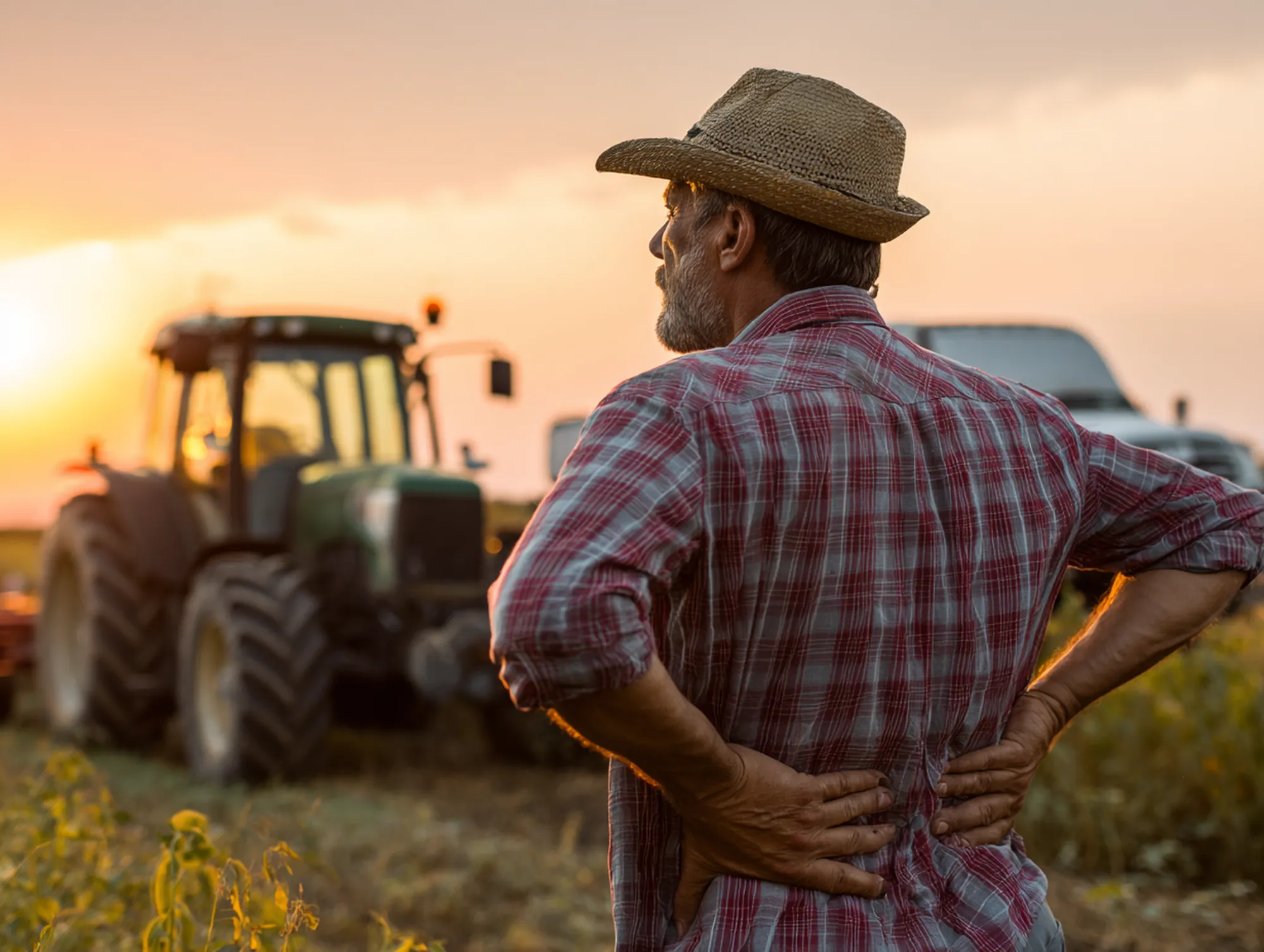
Tip 3: Take Breaks and Stretch it Out
During harvest rush, we know it’s tempting to push through dawn till dusk without stopping – but your back benefits from brief breaks. If you’re spending long hours in a tractor or combine seat, aim to pause at least every 1-2 hours[17]. Take a quick pit stop: hop out of the cab, walk around for a couple of minutes, and do a few simple stretches. This can increase circulation and relieve built-up pressure in your spine before it becomes painful[17].
Some easy stretches to do in the field:
- While standing, place your hands on your hips and gently arch backward, looking up at the sky. This counter-stretches the forward hunch from sitting. Hold for 5-10 seconds.
- Clasp your hands above your head and lean to each side, stretching out your sides and lower back.
- Roll your shoulders and do a few gentle neck circles.
- Touch your toes (or as close as you can get) to stretch your hamstrings – tight hamstrings tug on the lower back, so loosening them helps your spine.
At the end of the workday (or first thing in the morning), take 5–10 minutes to stretch your back, hips, and legs. Think of it as maintenance for your body. Regular stretching improves your flexibility and can prevent stiffness from setting in[21]. Some farmers in Chillicothe tell us a quick evening stretch or yoga routine makes a world of difference – they wake up the next day far less sore, ready to get back at it.
And don’t forget: stay hydrated and nourished. Muscles (including back muscles) fatigue faster if you’re running on caffeine and no water. Drinking water and eating throughout the day helps keep your energy up, which means better form and less risk of injury when you lift or twist. Harvest often coincides with warm early fall days in Missouri, so throwing a few bottles of water in the cab is as important as fuel in the tractor.
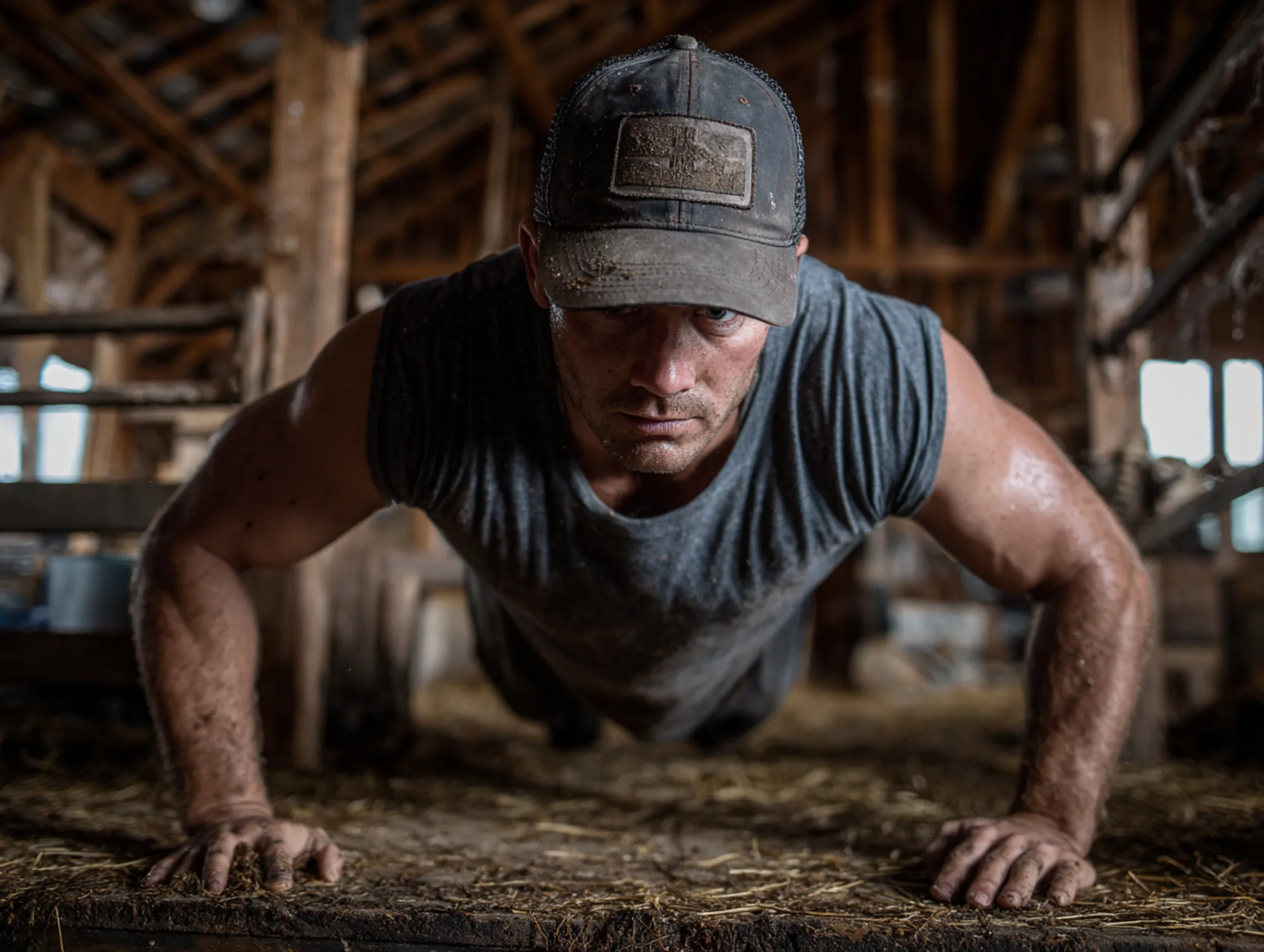
Tip 4: Build a Farmer-Strong Core
Your core muscles – the abdominals, obliques, and mid-back stabilizers – are the natural “back brace” God gave you. A stronger core means a more supported spine and less back pain[21]. Think of it like the frame of a barn; if the frame is solid, it takes stress off the walls. In your body, a solid core takes stress off your vertebrae.
You don’t need a gym to strengthen your core. Here are a few farm-friendly ways to build strength and stability:
- Morning plank: When you roll out of bed, hit the floor for a 30-second plank. Keep your body in a straight line (supporting yourself on forearms and toes). It engages your abs, glutes, and back muscles. Try to add a few seconds each week.
- Farm chore workout: Chores themselves can be workouts if done deliberately. For example, when carrying buckets, engage your abs (as if bracing for a punch) and keep your back straight – you’re basically doing a Farmer’s Walk exercise. When shoveling or raking, focus on using your core to drive the motion, not just your arms.
- Off-season conditioning: In the slower winter months, invest a little time in core exercises. Even just a 10-minute routine a few times a week – planks, side planks, bird-dogs, and gentle back extensions – will pay off by planting season. Many farmers who suffer back injuries lack core strength to support the heavy work. By spring, you could have abs as solid as your tractor frame!
Strong core muscles not only prevent back pain[21] but also improve your balance and endurance, making every farm task a bit easier. Pair this with general fitness (like regular walking, which most farmers get plenty of) and you’ll feel more resilient. As an added bonus, staying active and strong sets a great example for the next generation on the farm.
Finally, pay attention to posture in everyday life too. It’s easy to slouch at church or while driving to town. But if you practice sitting and standing tall (ears over shoulders, shoulders over hips), those habits will carry into your work as well. Good posture can reduce chronic lower back strain over time.
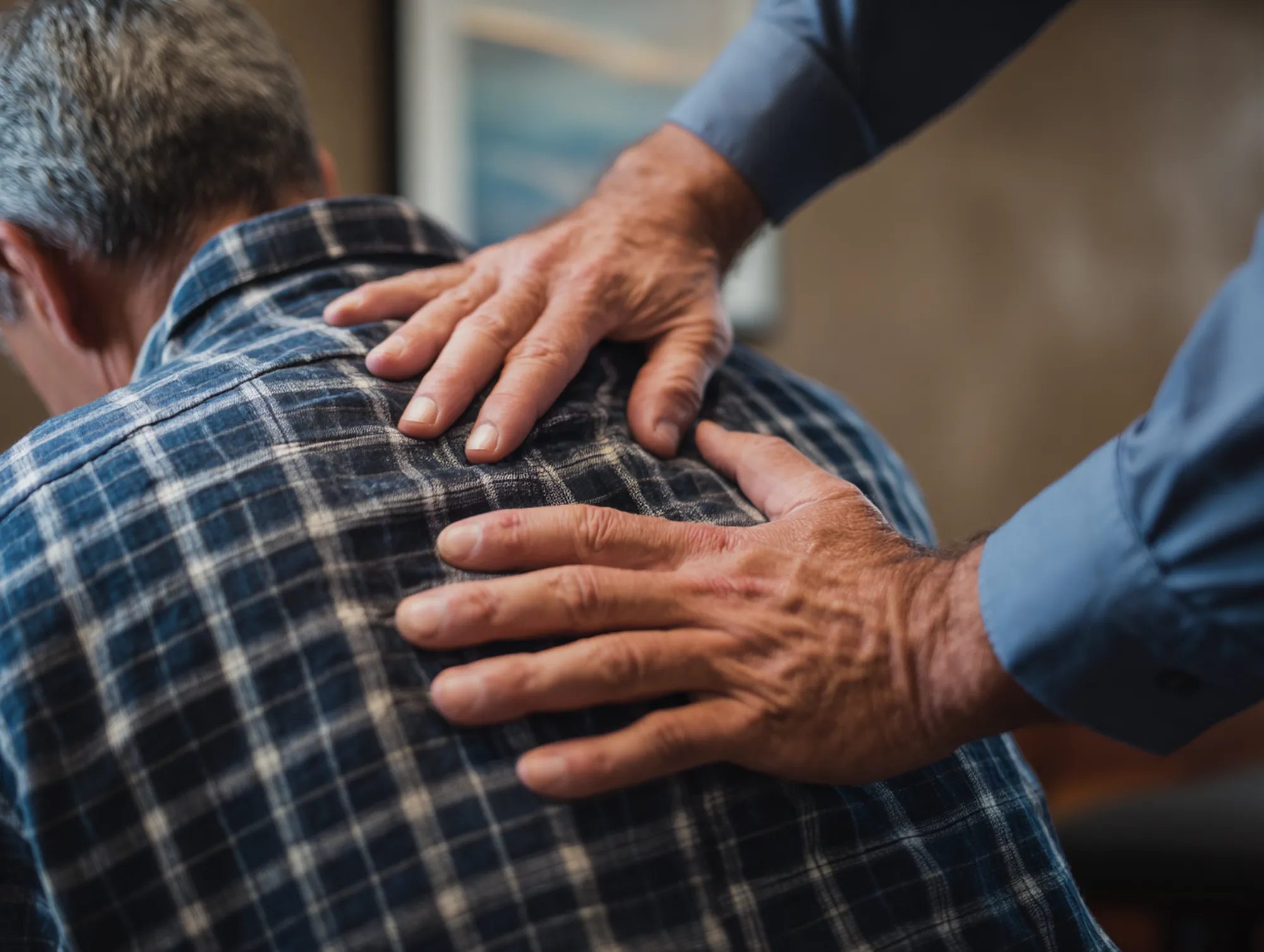
Tip 5: Don’t Ignore Pain – Get Adjusted and Stay Aligned
Farmers are known for their toughness – working through pain is almost a badge of honor. But there’s a difference between normal muscle soreness and an injury. If your back is hurting day after day or you feel sharp twinges, don’t just push through it. Ignoring serious pain can lead to worse problems down the line. It’s much easier to fix a minor issue now than a blown-out back during peak harvest.
One smart strategy is to include regular chiropractic care as part of your routine maintenance, just like you maintain your equipment. We’ve seen firsthand how keeping the spine in alignment helps our local farmers: when your joints move properly and nerves aren’t pinched, you have less pain, better flexibility, and you recover from the daily grind faster. Chiropractic adjustments can relieve pressure on spinal nerves and correct misalignments caused by all that bouncing on the tractor or hefting feed bags. Many farmers tell us they simply feel looser and more mobile after an adjustment – like someone oiled their rusty hinges.
At The Well-House Chiropractic, we’ve helped farmers from Chillicothe and surrounding towns get back to pain-free work even in the thick of harvest. For example, if you come in with a stiff, achy back, we might perform gentle spinal adjustments to improve your alignment, use cupping therapy or muscle work to ease tight knots, and show you some targeted stretches to do at home. By addressing the issue early, you can prevent a small strain from becoming a season-ending injury. Plus, an adjustment or two during harvest can be a great “tune-up” that keeps you in top form until the last crop is in.
Also, don’t underestimate the value of a professional evaluation if you’re hurting. Sometimes what feels like simple back pain could be a herniated disc, sciatica, or arthritis flare-up. A chiropractor (especially one like Dr. Arthaud who understands rural lifestyles) can assess what’s going on and refer you for further care if needed. We’re here to help you find solutions that keep you farming safely, whether that’s bracing, specific exercises, or treatment in our clinic.
Listen to your body. Pain is your body’s way of saying “something’s not right.” If rest, stretching, and over-the-counter measures aren’t helping, pick up the phone. Getting help before you’re completely laid up will save you downtime in the long run. Remember, the goal is to keep you doing what you love for years to come.
Now Scheduling
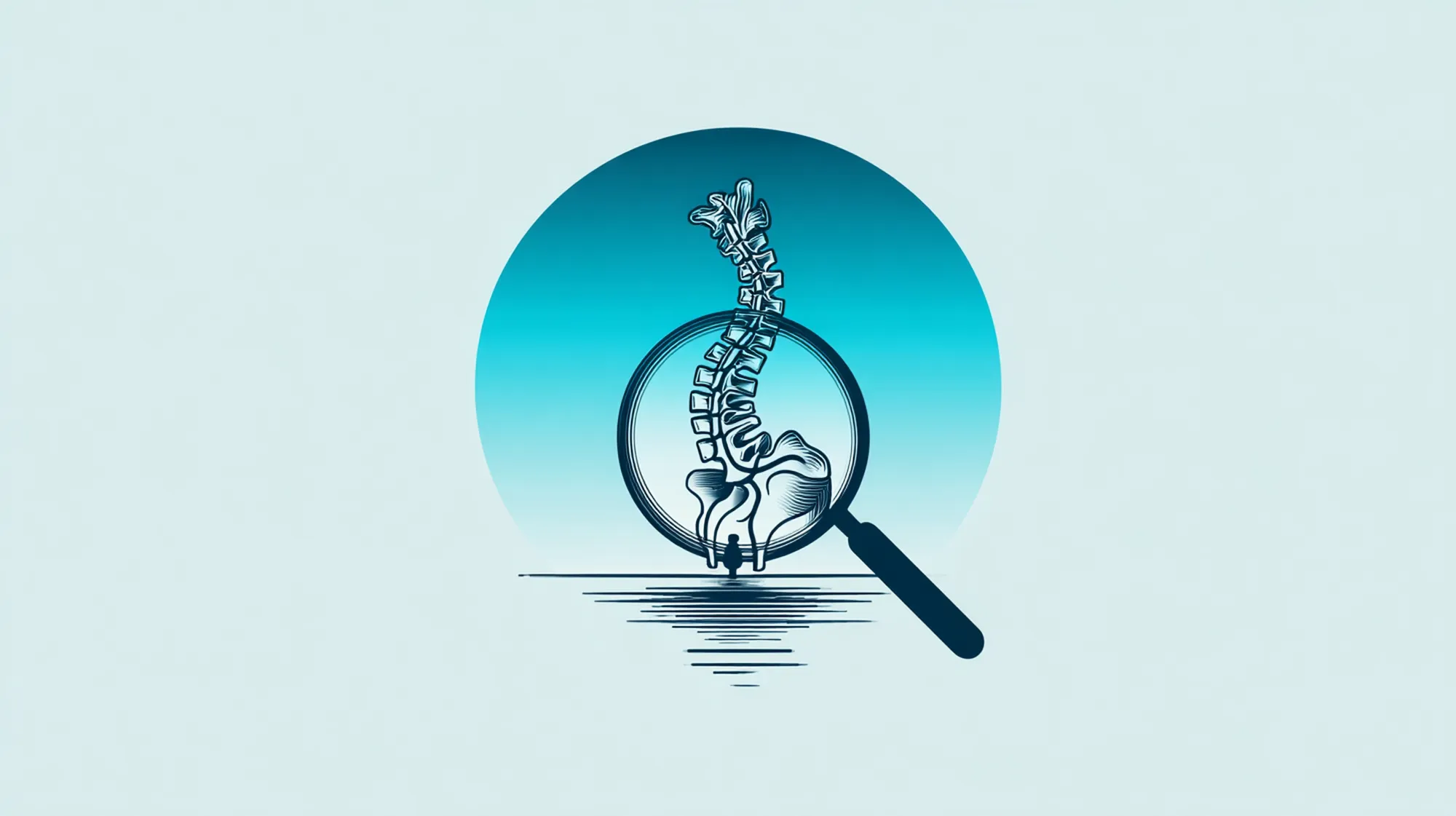
FAQs
What are the most common causes of back pain for farmers?
Farmers often face back pain from a combination of heavy lifting, repetitive motions, long hours on machinery, and awkward body positions[8][5]. Lifting heavy objects (like hay bales or feed bags) can strain muscles and even damage discs if done incorrectly. Constant vibration from tractors and combines contributes as well – the machine’s shaking transmits to your spine over time[6]. Add in bending, twisting, and working in uncomfortable positions (cleaning pens, repairing equipment under a wagon, etc.), plus sitting for hours during harvest, and it’s no surprise farmers have higher rates of back pain than most folks. Essentially, the day-to-day tasks of farming put repeated stress on the back, which can build up and cause pain without proper precautions.
How can I lift heavy things without hurting my back?
The key is to lift with your legs, not your back. Always bend your knees and squat down when picking up something heavy, instead of hinging at your waist. Keep the object close to your body as you lift – don’t extend your arms far out. This reduces the leverage on your spine[10]. Avoid any twisting; if you need to turn while holding something, move your feet so your whole body turns together. Whenever possible, break loads into smaller parts (carry two 25 lb. bags instead of one 50 lb., for example). Use equipment like dollies, skid loaders, or hoists to handle the heaviest items – that’s what they’re made for[12]. If an object is simply too bulky or heavy, ask for help rather than risking injury. It’s better to have a two-person lift than one person in the ER with a blown-out back.
My back gets stiff after sitting on the tractor all day. What can I do?
Long hours in the tractor seat will tighten up anyone’s back. First, make sure your seat is adjusted and supportive – you might need to add a lumbar cushion or get a seat suspension kit to smooth out the ride[13][17]. While operating, try to take short breaks: even stopping for 5 minutes every hour or two to step down, walk around, and stretch can prevent a lot of stiffness[17]. Do some gentle back bends or side bends next to the tractor to stay limber. Also, use your mirrors more so you’re not twisting awkwardly to check equipment behind you (consider adding extra mirrors or cameras if visibility is tough)[16]. At the end of the day, spend a few minutes on flexibility exercises – it will help work out the kinks from all that sitting. And remember, don’t jump straight off the tractor when you dismount; climb down carefully using the steps to avoid jolting your spine[18].
Should I wear a back brace during farm work?
A back support brace can be useful in some cases, but it’s not a cure-all. If you’re doing a lot of repetitive heavy lifting in a day, a well-fitted lumbar support belt can help remind you to use good form and provide a feeling of stability. Many farmers feel it gives them a bit of extra confidence during strenuous tasks. However, you shouldn’t rely on a brace to lift things far beyond your capacity – it’s not a license to ignore proper technique. And make sure it’s not too tight; you want support, not a cinch that restricts your movement or breathing. It’s also wise to take the brace off when you’re done with high-strain work, so your core muscles don’t become lazy by relying on it all day. In short, a brace is one tool – it can help in moderation, but it’s no substitute for strong muscles and safe habits. If in doubt, ask your chiropractor or doctor if they think a brace is appropriate for your situation.
Can a chiropractor really help with farm-related back pain?
Absolutely. Chiropractors are trained to address the kinds of musculoskeletal strain and misalignment that come from hard physical work. In farming, you’re constantly subjecting your body to stress – lifting, bumping along in equipment, and so on – which can cause your spine to get out of alignment or joints to become stiff. A chiropractor will evaluate your spine and body mechanics. Through gentle adjustments, they can often reduce pain, improve mobility, and speed up your recovery from injuries. Many farmers use chiropractic care as a maintenance tool, getting adjustments periodically to keep their back and joints moving freely (kind of like a tune-up for your body). Another big benefit is that a good chiropractor will give you guidance on exercises, stretches, and ergonomic tweaks specific to your situation – it’s not just crack-and-go; we want to solve the root causes. We’ve seen farmers who could barely stand upright from sciatica or a strained back walk out of our Chillicothe clinic feeling significantly better after proper treatment. Of course, every case is different, and chiropractors will refer you to other medical professionals if you need additional care. But for many types of farm-related back pain – from muscle strains to pinched nerves – chiropractic offers a safe, drug-free path to relief that can get you back to work faster.
Sources:
\
- Southern Illinois University School of Medicine – “Farming and back pain – avoid the aches and pains.” (April 22, 2025). Explains why farmers have higher rates of back pain (heavy lifting, machinery vibration, etc.) and offers prevention tips like proper lifting, stretching, and ergonomic adjustments[1][8].
- Upper Midwest Agricultural Safety and Health Center (UMASH) – “Protect Your Back: Ergonomic Strategies for Preventing Pain while Farming.” (Oct 2022). Reports that 40% of surveyed Midwestern crop farmers had lower-back trouble in the past year, and 68% of those said it limited their work. Highlights common risky tasks (stooping, vehicle operation) and recommends ergonomic interventions[2][22].
- Utah State University Extension – “Preventing Back Injury While Working in Agriculture.” (AgrAbility Project). Detailed guide on farm ergonomics. Recommends using help and machinery for heavy lifting, adding steps to equipment (rather than jumping down), adjusting tractor seats, and taking stretch breaks to reduce back strain[18][17].
- Kansas State University Research and Extension – “Safety Tips for Farming with a Back Injury or Back Problem.” (MF3469). Suggests practical modifications for farmers with back issues: e.g., install extra tractor steps, use suspension seating, and take a break every two hours to stretch and improve lower-back circulation[11][17].
- SIU Farm Family Resource Initiative – Quote by Karen Stallman. Emphasizes that back pain isn’t an inevitable part of farming and can be prevented with modern techniques like proper lifting mechanics, core strengthening, assistive technology, and ergonomic interventions[3]. This reinforces the message that farmers can take proactive steps to protect their backs.
[1] [3] [4] [5] [6] [7] [8] [9] [19] [21] Farming and back pain – avoid the aches and pains
https://www.siumed.edu/blog/farming-and-back-pain-avoid-aches-and-pains
[2] [22] SPOTLIGHT: Protect Your Back: Ergonomic Strategies for Preventing Pain while Farming – Upper Midwest Agricultural Safety and Health Center
[10] [12] [15] [18] [20] Preventing Back Injury While Working in Agriculture | USU
https://extension.usu.edu/agrability/research/preventing-back-injury-while-working-in-agriculture
[11] [13] [14] [16] [17] MF3469 Safety Tips for Farming with a Back Injury or Back Problem

